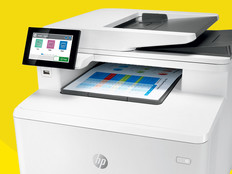Tech’s Role in Fighting the Ebola Outbreak
Technology is poised to play a key role in combating the worst Ebola outbreak the world has seen in the past 40 years.
The U.S. government is eyeing body sensors, ruggedized tablet computers, broadband communications and big data capabilities to aid its Ebola response. A high priority on the list is using innovative technologies to improve the protective gear worn by healthcare workers on the frontlines.
The gear doesn’t weigh much, but it’s suffocating, Armand Sprecher, the medical adviser to Doctors Without Borders for hemorrhagic fevers, told NPR. “If you wear something very fluid-resistant, it's also very air-resistant. It's hotter than hell. You're unable to wear the PPE [personal protective equipment] for more than 30 or 40 minutes in tropical heat.”
This severely limits the time workers can spend treating patients, according to the United States Agency for International Development. That’s why USAID, in partnership with other federal agencies and the Swedish government, recently launched Fighting Ebola: A Grand Challenge for Development. USAID outlined the project’s three goals:
• Engage the global community to identify ingenious ideas that deliver practical and cost-effective innovations in a matter of months, not years;
• Forge public-private partnerships necessary to test and scale these innovations; and
• Provide critical funding to get some of the most promising ideas into the field quickly.
The U.S. government is working to provide baseline data for innovators who will develop, test and scale solutions for addressing the Ebola epidemic.
Improving Protective Gear With Sensor Data
In West Africa, healthcare workers are being outfitted with sensors to collect body-temperature data. The sensor data will be used to improve the design of PPE to ensure that workers remain cool inside the gear, Steven VanRoekel, chief innovation officer at USAID, said at the GeekWire Summit in Seattle last week.
The hazmat-like suits are ideal for laboratory environments with air conditioning. “They weren’t made for western African summers,” said VanRoekel, who officially starts his new role on Monday. He served as federal CIO for the past three years, setting technology policy for the government.
Last month, VanRoekel announced via Twitter that he would be joining USAID to help with the Ebola response. He will serve as senior adviser to USAID administrator Rajiv Shah, according to Politico. This isn’t VanRoekel’s first stint at the agency. During the summer of 2011, he worked with USAID to respond to a drought in the Horn of Africa.
“At the end of the day, I’m a product guy, and I love driving direct impact,” VanRoekel told summit attendees of his decision to join USAID.
“It’s a meaty challenge where technology can actually come in and play a role … that maybe is not being utilized to the full extent at which it can,” he added.
VanRoekel envisions equipping healthcare workers with ruggedized tablets and wearable label printers that can replace paper-based processes in the field. Robust communications is another issue that must be addressed. Workers need the ability to upload and centralize data so it can be analyzed and to communicate with one another and the community. One possible scenario he’s mentioned is using social campaigns to send text message blasts to citizens of the infected countries, to help prompt behavioral changes.
Informing the Public Through Social Media
“We continue to communicate,” Sylvia Burwell, secretary of the Department of Health and Human Services, said at a press conference Friday. “We continue to give good instruction. I think it is important to reflect on whatever lessons we learn, we build and incorporate.”
In Dallas, where medical workers are treating the first Ebola patient to be diagnosed in the United States, 911 and 311 operators are getting trained to field the public’s questions about the virus, according to news reports.
Government agencies such as The Texas Department of State Health Services and the Centers for Disease Control and Prevention have used online posts and Twitter chats to disseminate timely and accurate information to the public. A big topic of discussion has been around Ebola patient Thomas Eric Duncan in Texas, his health and efforts under way to trace who he’s had contact with since traveling to the United States. (Duncan died Oct. 8).
Read our new fact sheet and find out what you need to know about #Ebola http://t.co/6I0jaD0lgv
— CDC NCEZID (@CDC_NCEZID) October 5, 2014
Daily #Ebola contact tracing updates will be posted at http://t.co/gamo6uFpO7.
— DSHS Press Office (@TexasDSHS) October 6, 2014
VanRoekel is exploring the role that Big Data can play in tracing who infected people have had contact with , tracking travel patterns of those individuals and understanding the future needs of Ebola aid clinics.
“I’m probably hitting the tip of the iceberg on where technology can play,” he said.









